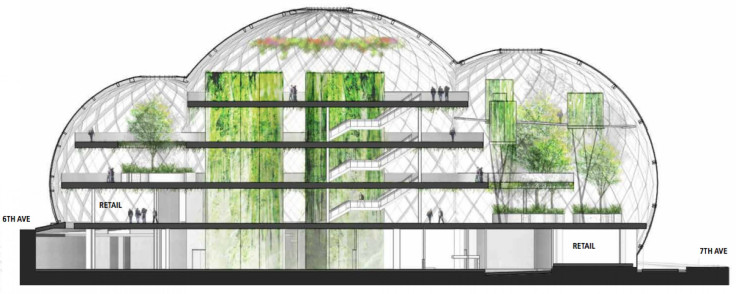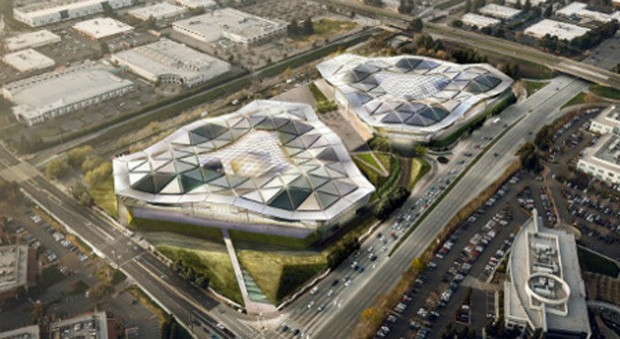5 Incredible Future Campuses For The World's Tech Giants [PHOTOS]
Besides hardware, software and consumer services, the world's tech giants have found another arena in which to battle one another for supremacy: real estate. There seems to be a competition for who can design the coolest next-generation company headquarters.
The latest entrant to the fray is Amazon, which joined Apple, NVIDIA, Google and Facebook in the battle for coolest campus with its announcement of a three-block biodome in the heart of Seattle. These eye-popping campuses, including Amazon's new rainforest-inspired HQ nicknamed "Rufus," are all several years away from being finalized (it could feel like decades considering how fast the technology world changes), but we have the layouts for each new campus. We want to know your opinion: Which one is the coolest, and which one is the least practical? Let us know in the comments section at the bottom of the page, but first, here are the campuses:
1. Amazon’s “Rufus”

Amazon has discussed its plans for the massive “Rufus” campus in Seattle -- with three 37-story office towers and a landscaped park -- for a while now. The most recent addition shows a pretty major addition: a massive greenhouse that will serve as a workspace. The three interconnected, 80-to-95 feet high domes will be divided in numerous, self-sustaining ecologies. In addition to plants, the five-story biodome will have office space, meeting rooms, lounges and dining. There are also plans for retail space so the public can check out the greenhouse.


2. Apple’s Halo Spaceship

Seriously, it looks like Apple has been playing too much of Microsoft’s popular first-person shooter franchise. The Apple Campus 2 will consist of 176 acres and feature one main building: a four-story ring that will total 2.8 million square feet. In addition to offices, the ring will have a restaurant, fitness center and even housing to help employees cut down on driving. Ironically, while a primary goal of the campus is to be environmentally friendly, the plans are currently on hold pending an environmental impact study by the city of Cupertino that may take until the end of June.
3. NVIDIA’s Polygons

With Apple taking the no-corners approach, NVIDIA went to exact opposite direction with designs for a pair of polygonal office buildings. The Santa Clara, Calif.-based company says its campus will focus on being eco-friendly, have lots of open space and reflect NVIDIA's love of art, collaboration and science. Given that the company is known for 3-D graphics, the polygons seem appropriate.
4. Google’s Bay View

Google’s current campus, the Googleplex, has already won the contest for best-named HQ, but the ever-growing company already has plans for a second facility in Mountain View, Calif. Called "Bay View," the new Google campus will consist of nine buildings across 42 acres, all connected by bridges. The buildings will feature green roofs and plenty of natural light, and a curved floor plan is intended to encourage employee interaction. Engineer David Radcliffe says no employees will be more than a two-minute walk away from one another. Google plans to open Bay View as soon as 2015, meaning it could be the first of these next-generation campuses.
5. Facebook’s Park In Menlo Park

Facebook is looking to expand its home in Menlo Park, Calif., with 434,000 square feet across 22 acres of land. The plans show one large building resembling a warehouse with a rooftop park. The exterior is designed to integrate into the existing environment, and there will be an underground tunnel to connect the new buildings to the current ones.
© Copyright IBTimes 2024. All rights reserved.






















